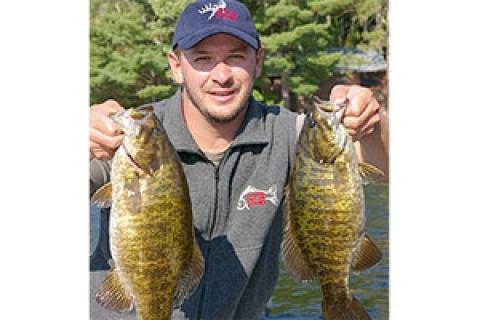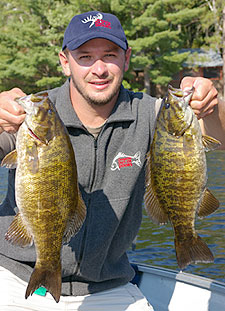
 |
| Humps hold a tremendous amount of potential, and are certainly capable of coughing up a true trophy. |
Out from shore, hidden from the naked eye, lies a fish-holding factory that is jam-packed with fins and gills from any and all species. Here they bask, undisturbed for the most part, until an intuitive angler finally uncovers them, and proceeds to enjoy the fruits of his labor. For those willing to put in the legwork for finding these out-of-the-way spots, the fishing can be non-stop and action-packed.
Come and explore the magical world of the underwater hump — they may not seem like much, but the trophy fish they hold will certainly convince you otherwise.
What is an Underwater Fishing Hump?
Although we read about "fishing humps" all the time, many don't get the true feeling for what one is. In basic terms, a hump is an underwater island. The crest or point of this structure will always fall below the surface of the water, ranging from mere inches to 20 or 30 feet. Most humps drop sharply on each side, forming the edges of the "island."
The basic composition of a hump is rock, but they can also be covered with sand or weed. In fact, a mixture of these different bottom compositions can often make them more attractive to fish.
Humps can be found anywhere and everywhere on a lake. Offshore humps are certainly the best, as with nothing else in the way of structure such a distance from shore, in many cases it is the only place for fish to happen upon.
But what brings fish to humps, and why do they occupy them? Two words: food and rest. Schools of deep-water minnows and baitfish use humps as resting points as they travel across the lake. The same scenario applies to larger predators, but they are also there for the food that humps provide. Like clockwork, baitfish attract smaller predators, and on down the food chain it goes.
Top of the line predators can rest up and feed to their hearts content, with easy access to deep water always close at hand.
Many fish will stage out from the humps, suspended over deep water during the daytime, heading onto the hump during morning and night to chow down on an easy meal.
 What Types of Fish Will You Find?
What Types of Fish Will You Find?
Almost all specie of fish will relate to, or frequent humps. From bass, walleye and musky to pike and perch - humps will hold all of them when conditions are to their liking. Walleye and smallmouth bass are two species that go hand-in-hand with humps. They will sit on the top during low-light periods or inclement weather, shifting back to the edges when sunlight becomes too strong. For humps whose peaks are still under 20 feet of water, fish can stay up on the top for the entire day. If food is readily available, they really have no reason to leave.
How to Find Underwater Fishing Humps
Since underwater humps are invisible to the eye, finding them can often be a problem. Topographic maps are your first step in finding them. Pour over a map of the lake you intend to fish, making note of any shallow depths surrounded by deep water. These spots will appear quite small on a map, and the quicker the depths change around the peak of the hump, the sharper the edges and breaks will be. Case in point - if you locate a marking showing five-feet on the map, a mile out from shore and surrounded by 40-foot depths, you've got yourself a hump. If no other numbers are shown other than five and 40, you can deduce that it will be a very extreme drop from shallow to deep.
 |
| Jigging and humps is a match made in heaven — it allows you to probe every single inch of a humps surface. |
Once you've located a series of humps on the map, it's time to get out in the boat and find them. The only way possible to do this when on the water is through the use of a fishfinder or flasher. By running down the lake, and by using your topo map as a guide, you can quickly locate your pre-found humps. Once you've discovered your first, toss a marker buoy on the shallowest crest of the hump in order to mark the area. These markers can be a lifesaver, as once the wind blows, it can be very easy to lose your spot and drift away from the action. Having a buoy visible on the surface will allow you to fish the top of the hump efficiently and effectively, while also giving you a good idea of where the drop-offs occur. Of course, finding the subtle differences and changes in the hump can be done with your fishfinder while working your way around the structure, using your boat tolling motor for quiet movement.
Many of the professionals punch the coordinates of a hump into their onboard GPS. This can be a tremendous help for locating the exact spot the next time you hit the lake.
Some humps that come within feet of the surface can be spotted with the naked eye, as many will have a milk jug or marker buoy warning boaters of the imminent danger to lower units. Many people overlook these humps due to the fear factor, but by approaching them slowly and with the electric motor, the really are harmless. (These extremely shallow humps have proven to be my favorite when it comes to topwater smallies, both early and late in the day!)
How To Fish Underwater Fishing Humps
When it comes to fishing humps, casting and trolling are definitely the way to go. Trolling is a great technique for working larger humps (and those that are deeper than 10-feet under the surface,) especially as a means to locating fish. My favorite technique is to troll across the very top of the hump, gradually moving outwards and around until I connect with a fish. Remember, fish may be staging on the outside of the hump over deeper water, so always make a few passes across this area. Try to get your crankbait to make contact with the hump itself - this stirring up of the bottom composition can often trigger strikes, especially when dealing with some of the bigger, toothier critters. If you connect with a fish or are marking some on the graph that refuse to bite, it's time to slow down and fish them vertically.
Jigging and humps is a match made in heaven. Jigs will allow you to probe every single inch of a humps surface, and will often catch fish when other techniques aren't working. Tubes for smallies and twistertails for walleye are a proven two.
Casting topwaters to the peaks of humps is a great way to get into some aerial acrobatics. Smallmouth and musky are always willing combatants, and as stated before, a great time for action is during those early mornings and late evenings.
Dragging livebait rigs across the face of a hump is a tremendous technique for cashing in on walleye. Crawler harnesses drifted or backtrolled has accounted for many walleye over the years. Slip floats and minnows or leeches can also work great when you anchor your boat off the edge of the hump, and cast your presentation right up on top.
Humps hold a tremendous amount of potential, and are certainly capable of coughing up a true trophy. One of the great things about them is, on many of the days, you'll be the only one fishing them. They only take a bit of detective work to find, and once you do, the fishing can be easy and the catching even greater. Take a tour of a hump this season - you'll be certainly glad that you did.
- 10002 views

